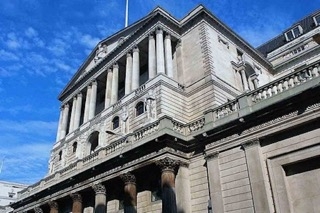
Bank pushes up base rate from 1.75% to 2.25%

The Bank of England today pushed up its base rate by 50 basis points from 1.75% to 2.25% as it intensifies its drive to curb inflation which is nearly 10%.
The base rate is now the highest it has been for over 10 years. Rates this high were last seen during the financial crisis of 2008.
There was shock last month when the Bank of England raised its base rate by 50 basis points from 1.25% to 1.75%.
Mortgage rates have risen since and so have savings rates.
This time the Monetary Policy Committee voted to increase the base rate by 5-4, a much closer margin than usual. Some commentators believe a 75 basis point rise was close to being backed.
Experts say further base rate increases this year are possible as the Bank struggles to keep a lid on inflation, which could rise towards 13%, some experts have warned.
The recently announced cap on energy prices is expected, however, to help keep inflationary pressures down, the MPC said. The MPC now predicts CPI will peak near 11% in October due to the energy cap.
Last year the base rate hit a low of 0.1%.
The current rate of CPI inflation is 9.9%, a 40 year high, and has been rising rapidly. The target remains 2%.
Adam Ruddle, chief investment officer at LV=, said: “While an increased rate helps tackle inflation it hinders economic growth. The Bank’s views on inflation have fallen as a result of the Energy Price Capping initiatives but risks have increased that inflation may remain entrenched for longer than previous expected. This likely means that interest rates will continue to rise and remain at higher levels for longer. We anticipate that interest rates will continue to rise and reach 3.75% by the end of 2023.”
Hinesh Patel, portfolio manager at Quilter Investors, said: “Markets were expecting a larger 0.75% increase, following the same increase yesterday by the (US) Federal Reserve which pushed sterling to its weakest against the dollar since 1985. The Bank of England continues to be on the back-foot and playing catch up with the Fed, and at 2.25% UK rates lag the 3-3.25% range in the States.
“The BoE also missed an earlier window of opportunity to, at the very least, dampen the impact on sterling. Instead, the Bank is now in a quandary of how to set policy rates with fiscal uncertainty and a ratcheting up of government borrowing. The Reagan-esque policies being pitched by the new cabinet may boost growth, but in our opinion will add to core inflationary pressures in the medium term."
Dr Matthew Connell, director of policy and public affairs at the Chartered Insurance Institute, said “It may seem strange that at the same time as the Government has announced a huge bailout for households to make energy bills more affordable, the Bank of England is making mortgages less affordable.
“However, the interest rate rise will have a bigger impact on higher income households, as research published by the Institute of Fiscal Studies early in September has shown. So this rise will help to calm spending by higher income households, without removing the vast majority of fiscal help going to smaller households."
Luke Bartholomew, senior economist, Abrdn, said: “Not long ago, a 0.5 percentage point interest rate increase in one meeting would have been seen as a very large and rapid increase in borrowing costs. However, given the much larger rate increases we have seen from a number of central banks across the world, a 50bps increase actually looks rather small today.
“The Bank of England therefore continues to look like something of a laggard compare to international peers, which is likely to keep the pound under selling pressure. Market attention will now move to the fiscal announcement from the government tomorrow, which looks set to deliver a significant easing in fiscal policy. Given the degree of underlying inflation pressure in the economy, this fiscal easing will almost certainly be met by a series of further interest rate hikes from the BoE.”
